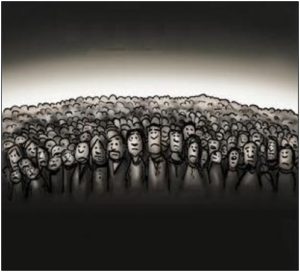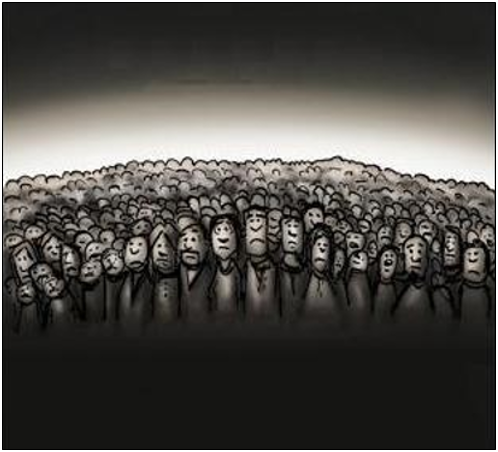
The White House Office of Management and Budget (OMB) in the now-released President’s Budget is projecting just 0.6 percent in inflation-adjusted real growth of the U.S. economy in 2023 as the unemployment rate is expected to rise to 4.3 percent in 2023 and peak at 4.6 percent in 2024 after the economy is finished overheating from the continued, elevated inflation, consumers max out on credit and spending falls off a cliff.
With 165 million Americans in the civilian labor force, that is the equivalent of about 1.99 million jobs expected to be lost, but if the unemployment rate projection is as expected, the number will almost certainly be higher than that, as the unemployment rate does not account for Americans who will lose their jobs and, on a net basis, give up looking for work in the midst of a recession.
That is why for example, in the U.S. Bureau of Labor Statistics’ (BLS) household survey, during the Covid recession of 2020, more than 25.4 million Americans said they had lost their jobs, but only 17.3 million more were said to be unemployed. The amount of Americans who reported having jobs dropped from 158.7 million in Feb. 2020 to 133.3 million by April 2020, whereas the number who reported being unemployed rose from 5.7 million to 23 million.
Again, the key metric explaining the difference between the two figures are those who end up dropping out of the labor force altogether. Simply put, if you’re not looking for work, you’re not considered unemployed—even if there are no good jobs to be sought in your city or town.
Similar incongruities can also work in reverse, for example, with the March 10 unemployment report by BLS, which shows the civilian labor force increased on a net basis 419,000, but only 177,000 more said they had jobs, and so the unemployed number increased by 242,000. As a result, the unemployment rate for Feb. 2023 ticked up from 3.4 percent to 3.6 percent. Surely, a lot of Americans did lose jobs—else how did the number of unemployed increase?—it’s just that more said they had jobs. So there’s a lot of churning there.
Sure enough, the number of Americans on continued unemployment claims, not seasonally adjusted—seasonal adjustments can become less meaningful during recessions—ticked up 83,400 to 1.97 million the week of Feb. 25, according to the Department of Labor. Continued unemployment claims are now up by 785,000 since Oct. 2022, when they were 1.19 million. And yet, the number of unemployed has supposedly decreased by about 100,000 from 6 million in Oct. 2022 to 5.9 million in Feb. 2023.
The difference there has to do with the fact that the household survey is just that, a survey, while non-seasonally adjusted continued unemployment claims actually count the number of people collecting unemployment benefits in states on a continued basis. Over time, these disparities tend to even themselves out on a net basis as wider numbers of Americans lose their jobs in more localities across America, and it turns up in the dataset.
The new, gloomy White House economic outlook and the rising level of unemployment, are at odds with prior proclamations by President Joe Biden that there might be no recession, despite the high inflation and other reliable indicators such at the 10-year, 2-year treasuries spread being inverted for almost a year now.
On July 17, 2022, White House Council on Economic Advisors member Jared Bernstein stated, “It is very hard to conclude that we are in a recession when you look at the payroll and the job gains that we’ve seen now, it is tricky to look around the corner here, and I’m not going to predict quarters down the road. But I think right now, you’ve got inflation headwinds big time in this economy – not taking anything away from that – but you also have some very strong tailwinds that are boosting consumers.”
That came on the heels of President Joe Biden telling the Associated Press in June 16, 2022 that a recession was “not inevitable”: “First of all, it’s not inevitable. Secondly, we’re in a stronger position than any nation in the world to overcome this inflation.”
This, as the Federal Reserve has stubbornly refused to take the Federal Funds Rate, which effectively is at 4.3 percent—the rate the Federal Reserve lends to banks—above that of the consumer inflation rate, which is still at 6.4 percent.
All that said, due to the Baby Boomer retirement wave and ongoing resulting labor shortages, should the unemployment level only reach 4.6 percent in the ensuing recession, that would altogether not be too high relative to other more severe recessions including the 2008-2009 financial crisis and Great Recession and the 2020 Covid recession. What’s somewhat surprising is the White House and OMB were willing to put out economic projections that were not mere happy talk even if they ultimately end up understating the severity of the recession, but we’ll have to wait and see what the President proclaims from the bully pulpit, lest he be accused of “talking down the economy.” Stay tuned.
Robert Romano is the Vice President of Public Policy at Americans for Limited Government Foundation.
